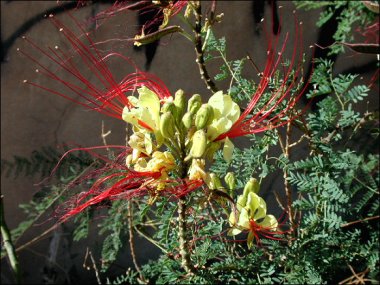

Over the years, people move into an area, build their homes, and as other opportunities beckon, move on. While driving the back roads of the Chihuahuan Desert, linear mounds marking abandoned homes sometimes appear unexpectedly to the side. These are the remnants of adobe walls, crumbled over the years under the onslaught of scanty desert rains. And occasionally, nearby, a shrub with bright yellow flowers and long, prominent, red stamens stands proudly, having outlasted its patrons.
This showy plant is the Bird-of-Paradise, a native of arid regions of Argentina that is widely planted in the U.S. and Mexico as an ornamental. But not all have been deliberately planted—escapees are not uncommon and thrive in our desert without overwhelming the native plants.
A flamboyant display for the eye and an attractor of hummingbirds, the
Bird-of-Paradise has few drawbacks. This is an alien that has made itself at home. And
unlike so many of the plants and animals that have arrived uninvited to the Chihuahuan
Desert, the Bird-of-Paradise has settled in as a welcome neighbor.

Contributor: Arthur H. Harris, Laboratory for Environmental Biology, Centennial Museum, University of Texas at El Paso.
Desert Diary is a joint production of the Centennial Museum and KTEP National Public Radio at the University of Texas at El Paso.

A Bird-of-Paradise shrub, blooming beside the still standing wall of an abandoned building. Photograph by A.H. Harris.
Caesalpinia gilliesii. A site in Chile, en Español. Technical.